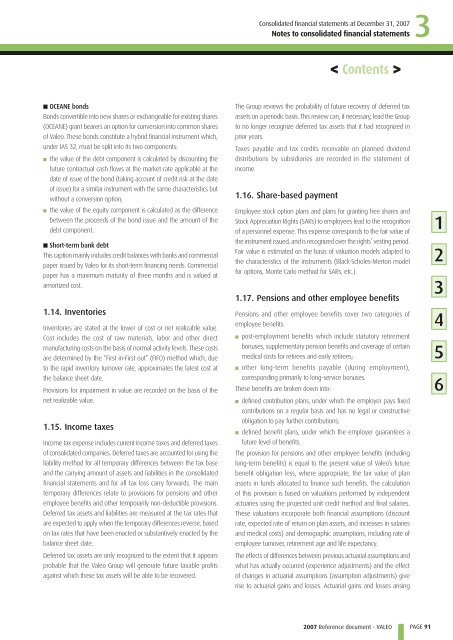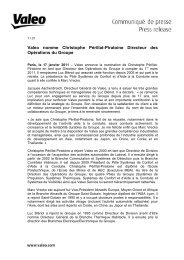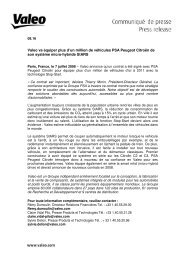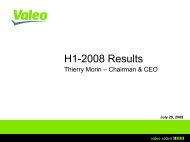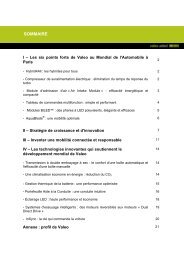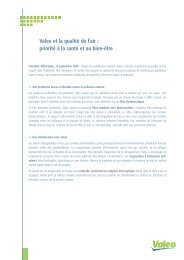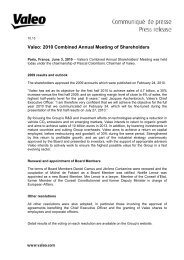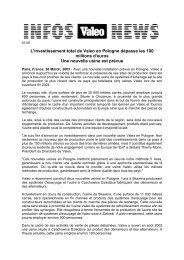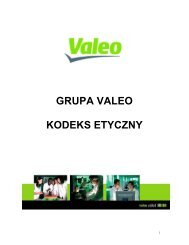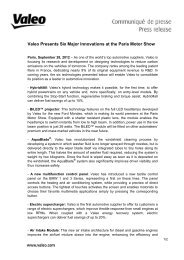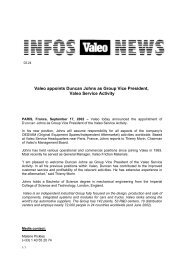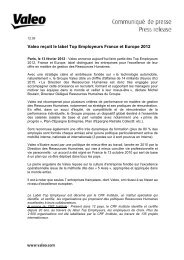2007 Reference document (PDF) - Valeo
2007 Reference document (PDF) - Valeo
2007 Reference document (PDF) - Valeo
You also want an ePaper? Increase the reach of your titles
YUMPU automatically turns print PDFs into web optimized ePapers that Google loves.
■ OCEANE bonds<br />
Bonds convertible into new shares or exchangeable for existing shares<br />
(OCEANE) grant bearers an option for conversion into common shares<br />
of <strong>Valeo</strong>. These bonds constitute a hybrid financial instrument which,<br />
under IAS 32, must be split into its two components:<br />
■<br />
■<br />
the value of the debt component is calculated by discounting the<br />
future contractual cash flows at the market rate applicable at the<br />
date of issue of the bond (taking account of credit risk at the date<br />
of issue) for a similar instrument with the same characteristics but<br />
without a conversion option;<br />
the value of the equity component is calculated as the difference<br />
between the proceeds of the bond issue and the amount of the<br />
debt component.<br />
■ Short-term bank debt<br />
This caption mainly includes credit balances with banks and commercial<br />
paper issued by <strong>Valeo</strong> for its short-term financing needs. Commercial<br />
paper has a maximum maturity of three months and is valued at<br />
amortized cost.<br />
1.14. Inventories<br />
Inventories are stated at the lower of cost or net realizable value.<br />
Cost includes the cost of raw materials, labor and other direct<br />
manufacturing costs on the basis of normal activity levels. These costs<br />
are determined by the “First in-First out” (FIFO) method which, due<br />
to the rapid inventory turnover rate, approximates the latest cost at<br />
the balance sheet date.<br />
Provisions for impairment in value are recorded on the basis of the<br />
net realizable value.<br />
1.15. Income taxes<br />
Income tax expense includes current income taxes and deferred taxes<br />
of consolidated companies. Deferred taxes are accounted for using the<br />
liability method for all temporary differences between the tax base<br />
and the carrying amount of assets and liabilities in the consolidated<br />
financial statements and for all tax loss carry forwards. The main<br />
temporary differences relate to provisions for pensions and other<br />
employee benefits and other temporarily non-deductible provisions.<br />
Deferred tax assets and liabilities are measured at the tax rates that<br />
are expected to apply when the temporary differences reverse, based<br />
on tax rates that have been enacted or substantively enacted by the<br />
balance sheet date.<br />
Deferred tax assets are only recognized to the extent that it appears<br />
probable that the <strong>Valeo</strong> Group will generate future taxable profits<br />
against which these tax assets will be able to be recovered.<br />
Consolidated fi nancial statements at December 31, <strong>2007</strong><br />
Notes to consolidated financial statements<br />
The Group reviews the probability of future recovery of deferred tax<br />
assets on a periodic basis. This review can, if necessary, lead the Group<br />
to no longer recognize deferred tax assets that it had recognized in<br />
prior years.<br />
Taxes payable and tax credits receivable on planned dividend<br />
distributions by subsidiaries are recorded in the statement of<br />
income.<br />
1.16. Share-based payment<br />
< Contents ><br />
Employee stock option plans and plans for granting free shares and<br />
Stock Appreciation Rights (SARs) to employees lead to the recognition<br />
of a personnel expense. This expense corresponds to the fair value of<br />
the instrument issued, and is recognized over the rights’ vesting period.<br />
Fair value is estimated on the basis of valuation models adapted to<br />
the characteristics of the instruments (Black-Scholes-Merton model<br />
for options, Monte Carlo method for SARs, etc.).<br />
1.17. Pensions and other employee benefi ts<br />
Pensions and other employee benefits cover two categories of<br />
employee benefits:<br />
■ post-employment benefits which include statutory retirement<br />
bonuses, supplementary pension benefits and coverage of certain<br />
medical costs for retirees and early retirees;<br />
■ other long-term benefits payable (during employment),<br />
corresponding primarily to long-service bonuses.<br />
These benefits are broken down into:<br />
■ defined contribution plans, under which the employer pays fixed<br />
contributions on a regular basis and has no legal or constructive<br />
obligation to pay further contributions;<br />
■ defined benefit plans, under which the employer guarantees a<br />
future level of benefits.<br />
The provision for pensions and other employee benefits (including<br />
long-term benefits) is equal to the present value of <strong>Valeo</strong>’s future<br />
benefit obligation less, where appropriate, the fair value of plan<br />
assets in funds allocated to finance such benefits. The calculation<br />
of this provision is based on valuations performed by independent<br />
actuaries using the projected unit credit method and final salaries.<br />
These valuations incorporate both financial assumptions (discount<br />
rate, expected rate of return on plan assets, and increases in salaries<br />
and medical costs) and demographic assumptions, including rate of<br />
employee turnover, retirement age and life expectancy.<br />
The effects of differences between previous actuarial assumptions and<br />
what has actually occurred (experience adjustments) and the effect<br />
of changes in actuarial assumptions (assumption adjustments) give<br />
rise to actuarial gains and losses. Actuarial gains and losses arising<br />
<strong>2007</strong> <strong>Reference</strong> <strong>document</strong> - VALEO<br />
3<br />
PAGE 91<br />
1<br />
2<br />
3<br />
4<br />
5<br />
6


